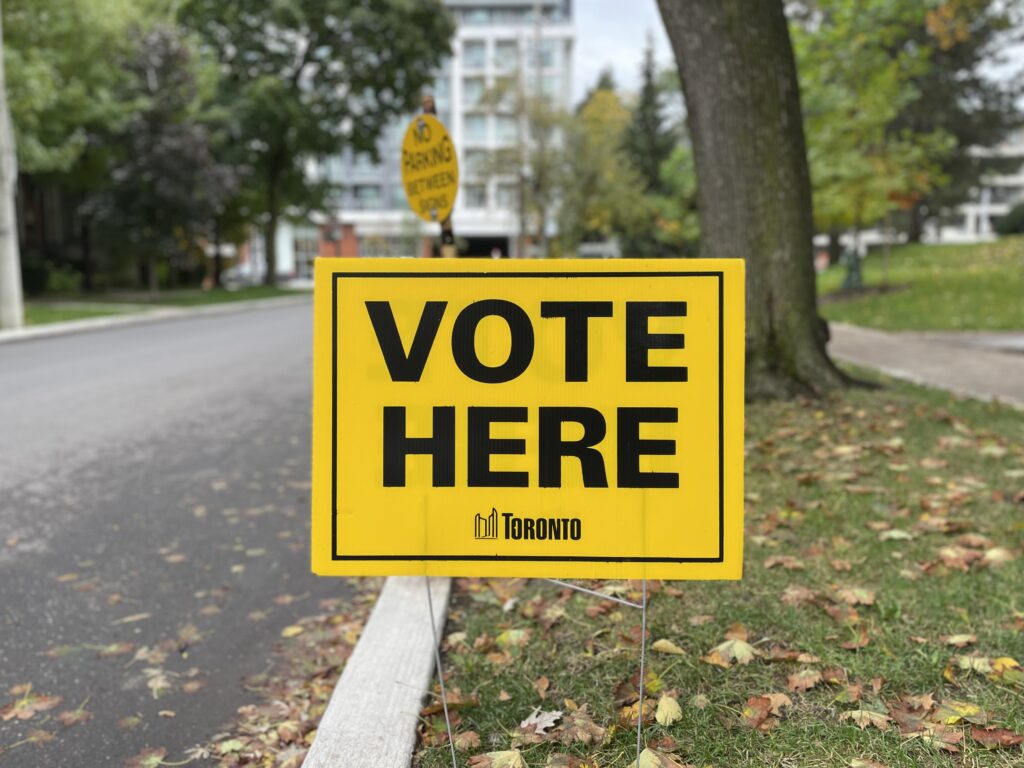
Listen to the audio version here:
Less than one-third of eligible Toronto voters cast a ballot for their next mayor on Oct. 24, according to the city’s unofficial results. The available data reveals a record low in voter turnout at 29 per cent.
This isn’t a new phenomenon: over the last two decades, fewer Canadians have been casting ballots in elections at all levels of government. Toronto has been on a steady decline since
its record-high turnout of 60 per cent in 2014 — the election after Mayor Rob Ford’s tumultuous time in office. Since the year 2000, voter turnout for federal elections has averaged about 63 per cent — a drop from the previous twenty-year period, in which average voter turnout was over 71 per cent.
The numbers are even worse when it comes to municipal and provincial elections. In Toronto’s 2018 election, voter turnout was 41 per cent. According to Elections Ontario, the provincial vote last June had a turnout rate of only 43 per cent — the lowest turnout ever for an Ontario provincial election.
TMU students are very familiar with this phenomenon. Jasmin Fisher, a first-year accounting and finance student, was planning to vote in Toronto’s recent election, but they were worried about being uninformed. “I definitely could do more research, I just don’t have time,” Fisher said. “I don’t really know enough to make this decision.”
Ria Bailey, another TMU student in fashion and design, echoed this feeling, especially in terms of municipal-level politics: “I feel like if you really want that information, you kind of have to seek it out yourself,” she said.
This lack of engagement is reflected in the data. Voter turnout today is especially low in younger demographics. The Samara Centre for Democracy reports that in 2015, 79 per cent of eligible voters aged 65 to 74 cast a ballot in the federal election. However, of the youngest age bracket of voters aged 18 to 24, only 57 per cent of people voted.
There is also evidence suggesting that some racialized Canadians, and Canadians facing other social barriers, vote less often than the population as a whole. A Statistics Canada study published in 2012 found that naturalized Canadian immigrants were less likely to vote than those born in Canada. The study also found that people were less likely to vote if they were not homeowners, had lower levels of education or worked 40 hours or more per week and in lower-skilled jobs.
In order to combat these issues, there are many groups working to improve civic engagement and voter turnout in Toronto, throughout Ontario, and across Canada. These groups are non-partisan. Their focus is on increasing voter turnout across the board.
Reaching Out to Voters
John Beebe is the founder of the Democratic Engagement Exchange. It is an organization that started at TMU in 2017 with the goal of engaging more people in the democratic process at every political level in Canada. The Exchange focuses on groups who are more likely to be disengaged in the voting process, like new citizens, young people and first-time or infrequent voters, partnering with other community organizations like food banks and libraries to promote non-partisan civic engagement. Through these partnerships, the organization provides training, like election readiness workshops that teach new voters what the voting process looks like ahead of each election.
The Exchange is not the only group working to involve young people. Future Majority, founded in 2018, is specifically devoted to engaging and amplifying the voices of young people in Canada. Communications director Camellia Wong explains that the group employs what’s called a relational organizing model: one in which participants connect with other people they know and trust, and encourage their peers to get engaged and to vote. Unlike traditional advertising on social media, with this model, Wong says that people are “way more likely to vote and turn out at a higher rate, because it’s someone that you have a personal connection to.”
In fact, this model has found success beyond Canada. Voters in Ohio, for instance, were 17 per cent more likely to be mobilized when involved in relational organizing — according to findings by American political scientists Donald Green and Oliver McClellan.
Though Wong is proud of the work Future Majority does, they say there are some barriers preventing people from accessing the political sphere and feeling engaged — especially young people of colour who may not see themselves represented in positions of power.
One organization trying to tackle that specific issue is Operation Black Vote Canada (OBVC), a Scarborough-based group that has been working since 2004 to increase Black representation at every level of government in Canada. For chair Velma Morgan, a lack of civic engagement is a direct result of poor representation: people are less likely to vote when they don’t see candidates who look like them. “It’s hard to be what you don’t see,” Morgan said.
Still, Morgan is motivated by the fact that she has seen an increase in the number of Black politicians running for office since OBVC was founded in 2004. While OBVC’s main goal is the election of Black Canadians, Morgan says that running for office “might not be for everybody,” and she encourages people to get involved in whatever capacity they can — whether that be joining a local board or committee, or simply heading to the polls.
Advocacy groups like these are not new, but they are facing added challenges today as voter engagement is in decline. Myer Siemiatycki, professor emeritus in politics at TMU, says that these grassroots efforts to increase voter turnout face real difficulties trying to inform and inspire people — especially youth — to get engaged in politics. “It’s very much an uphill battle,” Siemiatycki said.
Obstacles to Engagement
Siemiatycki applauds the Exchange’s efforts but says there is not enough grassroots organization happening to engage young voters, and much more outreach needs to be done in order to combat the issue properly.
Rather than only organizing during campaigns, advocacy groups can focus on the time between elections as opportunities for community engagement. Shams Nasri, a second-year student in occupational health and safety at TMU, says he sees a spike in his peers discussing politics right before an election. But, this does not always translate to going to the polls. “Nobody’s concerned until it’s election time,” said Nasri. “And even then, they’ll talk a whole bunch, and then they really won’t even go out and vote.”
This is why the Exchange aims to provide programming that strengthens local democracy year-round. “Between elections is definitely one of the times when we can be most impactful on issues that matter to us,” said Beebe. When elections are not coming up, the Exchange focuses on fostering dialogue for communities to start discussing issues they care about.
Some experts believe that engagement efforts focused on young people may not be targeted to have the greatest impact. In 2017, Kirt Goodridge of Dalhousie University published a study on get-out-the-vote advocacy, criticizing groups for spending too much time and effort on people like university students, who are already more likely to be engaged and be voters. Goodridge suggests in the study that the resources of such organizations would be better used targeting other segments of the population, like young people with no post-secondary education.
Morgan says that in her work she comes across many people who are not interested in voting because they do not expect anything to change in the political sphere, regardless of their vote. Still, she remains patient and optimistic. “I know that [change] is not going to happen in one election or two elections,” Morgan said. “It’s going to be over time.”
Wong agreed that work at Future Majority can be tiring or frustrating some days, but overall, they find it to be incredibly rewarding. They are encouraged to keep going by the enthusiasm of people they work with, including volunteers who are not even old enough to vote yet still eager to be involved in engaging more young people in the political process. “Civic participation only works and democracy is only healthy if it includes all of us,” Wong said.
Broadcast/Podcast/Social editor, On The Record, Fall 2022.
Broadcast/Podcast/Social editor, On The Record, Fall 2022.
Broadcast/Podcast/Social editor, On The Record, Fall 2022.

